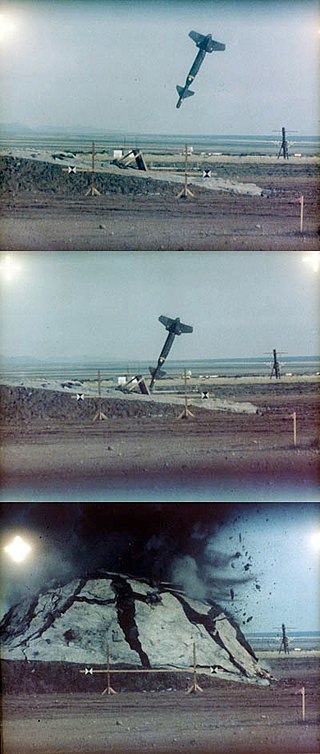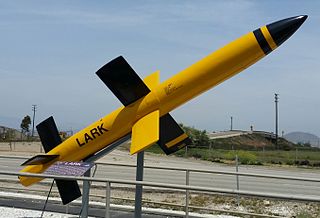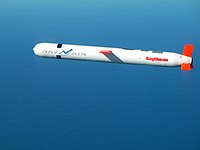
A ballistic missile (BM) is a type of missile that uses projectile motion to deliver warheads on a target. These weapons are powered only during relatively brief periods—most of the flight is unpowered. Ballistic missiles differs in range; short-range ballistic missiles (SRBM) stay within the Earth's atmosphere, while intercontinental ballistic missiles (ICBM) are launched on a sub-orbital flight. They are internally guided, those for short range are typically inertial-guided while those for long range typically have more sophisticated guidance.

An anti-ship missile (AShM) is a guided missile that is designed for use against ships and large boats. Most anti-ship missiles are of the sea-skimming variety, and many use a combination of inertial guidance and active radar homing. A large number of other anti-ship missiles use infrared homing to follow the heat that is emitted by a ship; it is also possible for anti-ship missiles to be guided by radio command all the way.

A projectile is an object that is propelled by the application of an external force and then moves freely under the influence of gravity and air resistance. Although any objects in motion through space are projectiles, they are commonly found in warfare and sports.

Anti-satellite weapons (ASAT) are space weapons designed to incapacitate or destroy satellites for strategic or tactical purposes. Although no ASAT system has yet been utilized in warfare, a few countries have successfully shot down their own satellites to demonstrate their ASAT capabilities in a show of force. ASATs have also been used to remove decommissioned satellites.

An air-to-air missile (AAM) is a missile fired from an aircraft for the purpose of destroying another aircraft. AAMs are typically powered by one or more rocket motors, usually solid fueled but sometimes liquid fueled. Ramjet engines, as used on the Meteor, are emerging as propulsion that will enable future medium- to long-range missiles to maintain higher average speed across their engagement envelope.

Missile guidance refers to a variety of methods of guiding a missile or a guided bomb to its intended target. The missile's target accuracy is a critical factor for its effectiveness. Guidance systems improve missile accuracy by improving its Probability of Guidance (Pg).

A ranged weapon is any weapon that can engage targets beyond hand-to-hand distance, i.e. at distances greater than the physical reach of the user holding the weapon itself. The act of using such a weapon is also known as shooting. It is sometimes also called projectile weapon or missile weapon because it typically works by launching solid projectiles ("missiles"), though technically a fluid-projector and a directed-energy weapon are also ranged weapons. In contrast, a weapon intended to be used in hand-to-hand combat is called a melee weapon.

An air-to-surface missile (ASM) or air-to-ground missile (AGM) is a missile designed to be launched from military aircraft at targets on land or sea. There are also unpowered guided glide bombs not considered missiles. The two most common propulsion systems for air-to-surface missiles are rocket motors, usually with shorter range, and slower, longer-range jet engines. Some Soviet-designed air-to-surface missiles are powered by ramjets, giving them both long range and high speed.

Wunderwaffe is a German word meaning "wonder-weapon" and was a term assigned during World War II by Nazi Germany's propaganda ministry to some revolutionary "superweapons". Most of these weapons however remained prototypes, which either never reached the combat theater, or if they did, were too late or in too insignificant numbers to have a military effect. The V-weapons, which were developed earlier and saw considerable deployment, especially against London and Antwerp, trace back to the same pool of highly inventive armament concepts. In the German language, the term Wunderwaffe generally refers to a universal solution which solves all problems related to a particular issue, mostly used ironically for its illusionary nature.

Nuclear weapons delivery is the technology and systems used to place a nuclear weapon at the position of detonation, on or near its target. Several methods have been developed to carry out this task.

The Weishi family of multiple rocket launcher systems were mainly developed by Sichuan Aerospace Industry Corporation in the central province of Sichuan, China at Chengdu city. The systems include the 302 mm (11.9 in) WS-1, the improved 302 mm (11.9 in) WS-1B, the 122 mm (4.8 in) WS-1E, the 400 mm (16 in) WS-2, as well as many other models. The WS-1 series weapon system did not enter PLA service and has order from Thailand. The WS-2 may finally see PLA service in the future. It's worth noticing that although sharing the same name, there are other developers for different models of Weishi series multiple rocket launchers (MRL) other than the primary developer SCAIC.

The ASM-135 ASAT is an air-launched anti-satellite multistage missile that was developed by Ling-Temco-Vought's LTV Aerospace division. The ASM-135 was carried exclusively by United States Air Force (USAF) F-15 Eagle fighter aircraft.

The Nimrod is a long-range air-to-surface missile developed by Israel Aerospace Industries. While designed for mainly anti-tank warfare, it provides standoff strike ability against a variety of point targets such as armoured personnel carriers (APCs), ships, bunkers, personnel concentrations, and guerrillas.

Project Kingfisher was a weapons-development program initiated by the United States Navy during the latter part of World War II. Intended to provide aircraft and surface ships with the ability to deliver torpedoes to targets from outside the range of defensive armament, six different missile concepts were developed; four were selected for full development programs, but only one reached operational service.
The Indian Ballistic Missile Defence Programme is an initiative to develop and deploy a multi-layered ballistic missile defence system to protect India from ballistic missile attacks. It was launched in 2000 after Kargil War by the Atal Bihari Vajpayee government. Testing was carried out and continuing as of 2006, and the system was expected to be operational four years from then according to the head of the country's missiles development programme, Vijay Kumar Saraswat.

A kinetic energy weapon is a projectile weapon based solely on a projectile's kinetic energy to inflict damage to a target, instead of using any explosive, incendiary/thermal, chemical or radiological payload. All kinetic weapons work by attaining a high flight speed — generally supersonic or even up to hypervelocity — and collide with their targets, converting its kinetic energy and relative impulse into destructive shock waves, heat and cavitation. In kinetic weapons with unpowered flight, the muzzle velocity or launch velocity often determines the effective range and potential damage of the kinetic projectile.

ALAS is a Serbian long-range multipurpose wire guided missile system developed by the private company EdePro and the state-owned Yugoimport SDPR. The ALAS missile system was developed primarily for missions against tanks, armored vehicles, fortifications, command posts, low-flying helicopters, coastal ships, industrial facilities and bridges. It can be deployed by any suitable platform including helicopters, armored vehicles, small ships and infantry. The guidance system is based on video/infrared technology, with the missile connected to the launcher by a fiber-optic cable. The ALAS flies at low altitude and has small radar and infrared (heat) signatures due to using a turbofan motor instead of a turbojet. In recent years, the ALAS platform has found a secondary use as a UAV.
The B-611 is a Chinese solid-fuelled short-range ballistic missile (SRBM) developed by China Precision Machinery Import-Export Corporation (CPMIEC). The missile has a maximum range of 150–400 km (93–249 mi).

The SAM-N-2 Lark project was a solid-fuel boosted, liquid-fueled surface-to-air missile developed by the United States Navy to meet the kamikaze threat. It was developed as a crash program to introduce a medium-range defensive layer that would attack targets between the long-range combat air patrols and short-range anti-aircraft artillery. This produced a design with roughly 30 miles (48 km) maximum range and subsonic performance, suitable for attacks against Japanese aircraft.


































